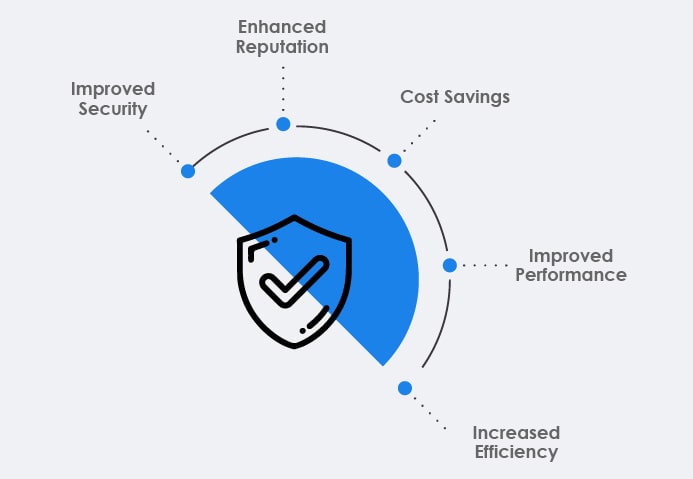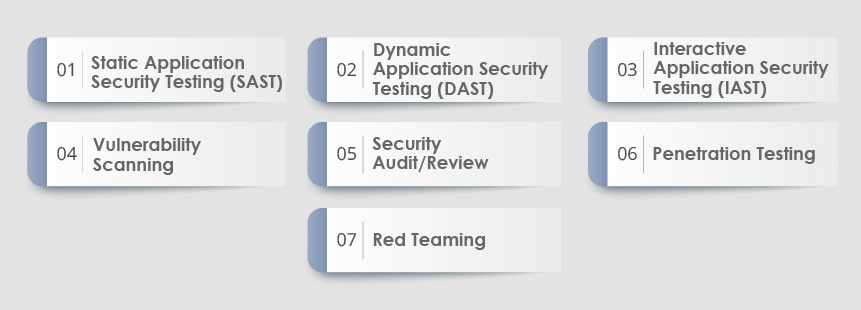Published: 17 Jan 2023
Web Application Security Testing – An Informative Guide for Beginners
Last Updated: 12 Oct 2023
Content
1. What is Web Application Security Testing?
2. Need for Web Application Security Testing
3. Business Benefits of Web App Security Testing
4. Different Software Testing Types for Web Application Security Testing
5. Web App Security Testing-Common Use Cases
6. Processes Involved in Web Application Security Testing
6. Trending Web Application Security Testing Tools in 2023
7. Conclusion
8. How can TestingXperts Help?
What is Web Application Security Testing?

Web application security testing is a process of identifying, preventing, and mitigating security vulnerabilities in web applications. It involves assessing the security of web applications by examining their code, architecture, and deployment environment. Web application security testing can be conducted manually or using automated tools to identify potential security risks such as cross-site scripting (XSS), SQL injection, buffer overflow, and malicious file execution.
The goal of web application security testing is to ensure that web applications are secure and do not contain any exploitable vulnerabilities that could lead to data breaches or other malicious attacks. Additionally, web application security testing helps organizations comply with industry regulations and standards such as PCI DSS and HIPAA.
Need for Web Application Security Testing

Web application security testing is an important part of any organization’s overall security strategy. As more and more businesses move to the cloud, they must have a secure web application to protect their data and ensure compliance with industry regulations. Web applications can be vulnerable to malicious attacks, so organizations need to test them regularly and take steps to protect them from potential threats.
The need for web application security testing arises from the fact that web applications are exposed to public networks and can be accessed by anyone with an internet connection. This means that attackers can easily exploit vulnerabilities in these applications and gain access to sensitive information or disrupt operations. Additionally, web applications are often used as entry points into other systems, such as databases or servers, which can lead to further damage if not properly secured. We have discussed the importance of web application security testing in our comprehensive security testing guide.
Overall, web application security testing is critical for any organization looking to protect its data and comply with industry regulations. By performing regular tests on their web applications, organizations can identify potential vulnerabilities early on and take steps to mitigate them before it’s too late.
Business Benefits of Web App Security Testing

Improved Security:
Web application security testing helps identify existing and potential vulnerabilities in the system, allowing businesses to take proactive steps to mitigate risks. This can reduce the likelihood of costly data breaches and other malicious attacks.
Enhanced Reputation:
Customers trust businesses that prioritize security, so by testing web applications regularly, businesses can demonstrate their commitment to protecting customers’ data and maintaining a positive reputation.
Cost Savings:
By detecting potential problems early on, businesses can save money by avoiding expensive repairs or replacements due to malicious attacks or data breaches. Additionally, web application security testing helps organizations comply with industry regulations, which could result in significant fines in the case of non-compliance.
Improved Performance:
Regularly testing web applications can help identify areas where performance is lagging, or inefficient processes exist that are causing delays or errors. This allows businesses to make necessary changes that improve overall performance and user experience.
Increased Efficiency:
By identifying any weak points in the system, web application security testing helps businesses streamline processes and increase efficiency across the organization by eliminating unnecessary steps or redundant tasks.
Different Software Testing Types for Web Application Security Testing

Static Application Security Testing (SAST):
This testing type is White Box Testing, which enables developers to identify security vulnerabilities in the source code of an application during the early stages of the software development life cycle. Through this method, it can be ensured that the application adheres to coding guidelines and standards.
Dynamic Application Security Testing (DAST):
This technique involves injecting malicious data into the software to simulate SQL injection and XSS attacks, with the goal of uncovering common security vulnerabilities. It is a black box or grey box security testing method which enables testers to identify potential weaknesses in web applications.
Interactive Application Security Testing (IAST):
It is a combination of both the SAST and DAST technique wherein an IAST agent is placed within an application that performs the analysis of the app in real-time. A large pool of Certified Ethical Hackers (CEHs) with years of expertise in delivering security testing services vulnerabilities to clients across domains.
Vulnerability Scanning:
In this testing process, automated software is utilized to examine vulnerabilities in the application. It analyzes web apps to perform vulnerability assesment for cross-site scripting, command injections, etc.
Security Audit/Review:
It is a cybersecurity testing approach that should be conducted on a regular basis. It enables digital businesses to assess the existing security status of their app by identifying vulnerabilities and security issues. It can either be accomplished manually or through automated testing tools.
Penetration Testing:
Penetration testing (or pen testing) is a security testing procedure where an authorized cyber-security expert tries to find and exploit vulnerabilities in an application. Penetration testing types are – Internal, External, BlackBox, and GreyBox.
Red Teaming:
It is a more comprehensive characterization of penetration testing where the internal or external group of security professionals simulate real-time attacks on the business. The security experts evaluate the infrastructure without any initial knowledge. The exhaustive evaluation is based on integrating various security controls of the organization.
Web App Security Testing-Common Use Cases

• Passwords must be encrypted
• Invalid users should not have access to the web app
• Browser back button should be non-functional on finance-based web apps
Processes Involved in Web Application Security Testing
Web Application Security Testing involves several critical processes to identify vulnerabilities and ensure a secure online environment. Let’s explore some of these key processes:
Brute Force Attack Testing: It evaluates the robustness of authentication mechanisms and systematically attempts numerous password combinations to gain unauthorized access. By simulating such attacks, security experts can assess the application’s resistance to these malicious attempts, identifying potential weak points in password protection.
Password Quality Rules: Testing password quality rules ensures the application enforces strong password policies. This involves examining whether the application mandates using a mix of characters, numbers, and symbols. Evaluating password length, complexity requirements, and expiration policies helps deter attackers from exploiting weak passwords.
Session Cookies: These are essential for authentication and maintaining user sessions. Security testing involves assessing the encryption and secure transmission of session cookies. By analyzing these cookies, testers can ensure that sensitive user data remains encrypted and that cookies are well-protected against theft or tampering.
User Authorization Processes: User authorization testing scrutinizes the application’s authorization mechanisms. This entails verifying that users are granted appropriate access privileges based on their roles. It also includes checking whether unauthorized users are correctly denied access to restricted areas of the application.
SQL Injection: SQL injection is a prevalent attack vector. Security testing involves deliberately attempting SQL injection attacks to identify vulnerabilities. Testers try injecting malicious SQL queries into input fields to determine whether the application is susceptible to unauthorized access or data breaches.
Trending Web Application Security Testing Tools in 2023

Burp Suite Professional:
Burp Suite is a comprehensive security testing platform with a popular feature of test automation that displays fewer false alarms. It is straightforward to set up and use, with the passive scan function enabling the capture of most sections of an object that may be overlooked. The Goals and scopes of security testing can be easily established with Burp Suite.
Veracode:
Veracode facilitates identifying and resolving security vulnerabilities in software. The tool enables a thorough evaluation of applications across the organization, including internally developed programs and external libraries. Developers can evaluate potential purchases, detect flaws in applications used with partners, and assess code that could be obtained through a prospective merger. Remediation reports prioritize flaws and repairs based on business goals and risk levels to optimize expenditure on software assurance.
Acunetix:
It is a comprehensive and effective solution for website, web application, and API security. It has the capability to detect over 4500 web vulnerabilities such as Cross Site Scripting (XSS) and SQL injection. Acunetix’s DeepScan Crawler can scan HTML5 sites and AJAX-based client-side SPAs.
Fortify:
Fortify Static Code Analysis (SCA) is a software security testing solution utilized by development teams and security experts to assess source code for potential vulnerabilities. It provides an analysis of the code and assists developers in recognizing, prioritizing, and resolving issues with greater efficiency.
OWASP ZAP:
It is an open-source pen-testing tool by OWASP which is particularly developed for testing flexible and extensible features of web apps.
OWASP Dependency Track:
The tool assists testers in visualizing and monitoring software components and libraries. OWASP Dependency Track enables testers to obtain a list of all current libraries and manage reported results. It is an open-source platform for component analysis which helps identify and reduce risks associated with software supply chains.
Conclusion
Web application security testing is a process used to identify, prevent, and mitigate security vulnerabilities in web applications. It involves examining the code, architecture, and deployment environment of web applications to ensure they are secure and do not contain any exploitable vulnerabilities that could lead to data breaches or other malicious attacks. Regular web app testing helps digital businesses identify potential vulnerabilities early, take steps to protect their data, and comply with industry regulations.
How can TestingXperts Help?

TestingXperts (Tx), is the next-gen specialist QA & software testing company, that has been helping clients with a range of security testing needs. Our team of Certified Ethical Hackers (CEHs) ensures that your application is secure from vulnerabilities and meets the stated security requirements, such as confidentiality, authorization, authentication, availability, integrity, and non-repudiation . Our dedicated teams have more than a decade of expertise in validating a wide range of applications for vulnerability and security threats and ensuring end-to-end security testing for identifying threats and vulnerabilities.
TestingXperts Differentiators:
• Flexible engagement models best suited to customer’s business needs
• In-house security testing accelerator Tx-Secure makes the security testing process quick and seamless and helps you achieve significant results
• Secure and well-equipped in-house security testing labs help perform effective security testing of all applications, including Blockchain, IoT, network infrastructure, etc.
• Security testing services have conformance with international standards and compliance, such as GDPR, HIPAA, PCI-DSS, OSSTMM, OWASP, SANS, NIST and others
• Deliver detailed test reports to stakeholders to make informed decisions